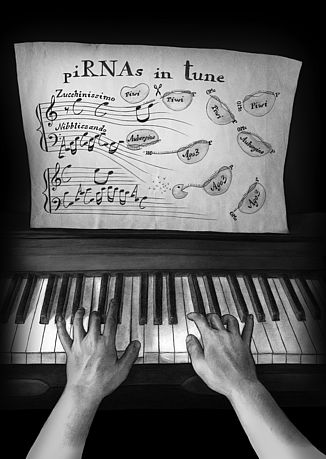A milestone in small RNA biology: piRNA biogenesis from start to finish

A melody played by two hands: Two evolutionarily ancient parallel pathways make up the 3’end of piRNAs. This illustration by Beata Mierzwa compares piRNA 3’ end formation to a piece of music where two pathways - involving Zucchini and Nibbler - play simultaneously to generate a diverse pool of piRNAs. The sheet music encodes characteristic nucleotide patters of the emerging piRNAs.
PIWI-interacting RNAs, or piRNAs for short, are a class of ‘small regulatory RNAs’—tiny pieces of nucleic acid just 22–30 nucleotides in length. They may be small, but with their associated Argonaute proteins, piRNAs have the power to ‘silence’ transposable elements, so called egoistic genes found in the genomes of plants, fungi, and animals. piRNA-guided silencing can act on chromatin to block transposon transcription, or by destroying transposon mRNAs in order to block their translation into proteins.
Although scientists understand quite well how piRNAs repress gene expression, until now, it has been much less clear how piRNAs are actually made. In a milestone research paper published in Nature, scientists from the Institute of Molecular Biotechnology in Austria (IMBA) have painstakingly unravelled the sequence of events that generate piRNAs with a defined length and sequence, a central requirement to define the target spectrum of the silencing system.
Mystery of piRNA biogenesis explained
Julius Brennecke, one of the paper’s senior authors, explained:
“We already knew that piRNAs are formed from longer RNA species that are chopped up into pieces by Argonaute proteins or a protein called Zucchini. This forms the 5' ends of so-called pre-piRNAs, which are loaded into Argonaute proteins and subsequently trimmed and modified to yield mature piRNAs. As we had a fairly good understanding of the generation of piRNA 5' ends, our group focused on the 3' ends, a process that was not understood for nearly ten years.”
Using the common fruit fly Drosophila melanogaster, a major genetic model organism, IMBA scientists Rippei Hayashi and Jakob Schnabl—both first authors of the article—revealed that piRNA 3' end formation in fact follows one of two parallel pathways.
“Once biogenesis is initiated, some piRNA 3' ends are actually generated by Zucchini, the endonuclease that is primarily known to generate piRNA 5' ends”, said last author Stefan Ameres. “But Zucchini explains the biogenesis of only a subset of piRNAs. We then discovered that the exonuclease Nibbler is a second key-enzyme that can form piRNA 3' ends and realized that two genetically separated pathways act in parallel in the cell. This was a true deja vu as we also found Nibbler to mature some microRNAs, yet another class of small RNA molecules, during my postdoctoral work.”
Two parallel pathways in tune
Beyond unravelling these pathways, their place of action, and their implications for downstream gene regulatory mechanisms, the team also made some interesting observations that might provide clues as to the evolution of small RNA biogenesis. “The nucleases we’ve identified in this study have homologs in animals ranging from sponges to human. Interestingly, some notable exceptions are apparent. Nematode worms, for example, have lost the Zucchini enzyme, and mosquitos from the Anopheles genus have lost Nibbler. Whether here other piRNA trimming mechanisms exist or whether in these species the two-pathway model is reduced to one, is unclear. Remarkably, upon simultaneous ablation of Zucchini and Nibbler in Drosophila, piRNAs can still be generated, in this case by closely spaced piRNA-guided Argonaute cleavage events. This Argonaute-only pathway might be the ancient piRNA generating system, onto which sophisticated nucleases like Zucchini and Nibbler were added later to enhance efficiency and accuracy of piRNA biogenesis,” concludes Julius Brennecke.
Original publication:
“'Genetic and mechanistic diversity of piRNA 3'-end formation'”, Rippei Hayashi, Jakob Schnabl, Dominik Handler, Fabio Mohn, Stefan L. Ameres & Julius Brennecke, Nature, November 16, 2016; doi: 10.1038/nature20162
Media Contact
All latest news from the category: Life Sciences and Chemistry
Articles and reports from the Life Sciences and chemistry area deal with applied and basic research into modern biology, chemistry and human medicine.
Valuable information can be found on a range of life sciences fields including bacteriology, biochemistry, bionics, bioinformatics, biophysics, biotechnology, genetics, geobotany, human biology, marine biology, microbiology, molecular biology, cellular biology, zoology, bioinorganic chemistry, microchemistry and environmental chemistry.
Newest articles

First-of-its-kind study uses remote sensing to monitor plastic debris in rivers and lakes
Remote sensing creates a cost-effective solution to monitoring plastic pollution. A first-of-its-kind study from researchers at the University of Minnesota Twin Cities shows how remote sensing can help monitor and…

Laser-based artificial neuron mimics nerve cell functions at lightning speed
With a processing speed a billion times faster than nature, chip-based laser neuron could help advance AI tasks such as pattern recognition and sequence prediction. Researchers have developed a laser-based…

Optimising the processing of plastic waste
Just one look in the yellow bin reveals a colourful jumble of different types of plastic. However, the purer and more uniform plastic waste is, the easier it is to…



